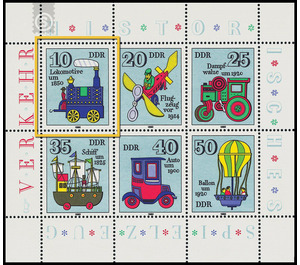Commemorative stamp series - Germany / German Democratic Republic 1980 - 10 Pfennig
Theme: Post & Philately
| Country | Germany / German Democratic Republic |
| Issue Date | 1980 |
| Face Value | 10.00 |
| Color | multi-colored blue |
| Perforation | K 14 |
| Printing Type | offset |
| Stamp Type | Postage stamp |
| Item Type | Stamp |
| Chronological Issue Number | 2308 |
| Chronological Chapter | GER-DDR |
| SID | 506100 |
| In 17 Wishlists | |
Historical Toys With the illustrations of historical toys in the field of traffic, the Ministry of Posts and Telecommunications of the German Democratic Republic issues six multicolored special postage stamps. The six postage stamps are printed together on a miniature sheet. No special First Day Cover envelope. Historic Toy Toy was and is always model of the environment. Of course, it can be adapted to the child's comprehension and its design reduced to the essential characteristics of the great role models. The historical toy pictured in the present series of stamps contains testimonials that have been designed according to the technical achievements of two centuries. At the same time, it makes important features of its manufacture under the conditions of home work and the publisher in the 18./19. Century as well as in the time of the boom industrially produced tin toys in the first two decades of our century clearly. In the course of the 18th century, as in many other commercial branches, homeworking and publishing became the basis of the socioeconomic structure of toy production based in the Erzgebirge and the Sonneberg region. The home industry at that time produced products that still bear unadulterated features of folk art. This can be seen on the Sonneberger soldier ship of the time around 1825 with its amiable naive design as well as on the 1850 manufactured locomotive from the Erzgebirge (10 Pfennig). The soldier ship, which was made as a toy toy, was certainly one of the treasures of the Sonneberger wooden toy in the 18th century. After ID Sunberger toy pattern books from the mid-19th century, it remained, like other motifs of Alt-Sonneberger wooden toys, for a long time in the offer of publishing. Immediately after the invention and construction of the railway their small images appeared on the toy markets. The Erzgebirge toy makers made an effort to copy this large-scale model in their own way, as the ornamentally treated surface of the wooden locomotive makes clear. With the invention of sheet pressing around 1815 in France, an important condition for the industrial production of tin toys was given. Thus, especially in the second half of the 19th century, in many European countries and in the US, major companies for the production of mechanical toys made of sheet metal. The use of this material, which conformed to large-scale models, enabled greater model loyalty, better conditions for the installation of a mechanism and was accompanied by constant efforts to refine the products. As a drive for railways and other mechanical toys found the movement very early use. Later, the flywheel drive was added, which was patented in 1904 by a German company. The selection of historical toys presented here highlights the value that this commodity, so important to the child's development, has as well as a cultural-historical document, as it bears witness to the creative abilities of its producers as well as to the efforts of society in the play of the child ,


